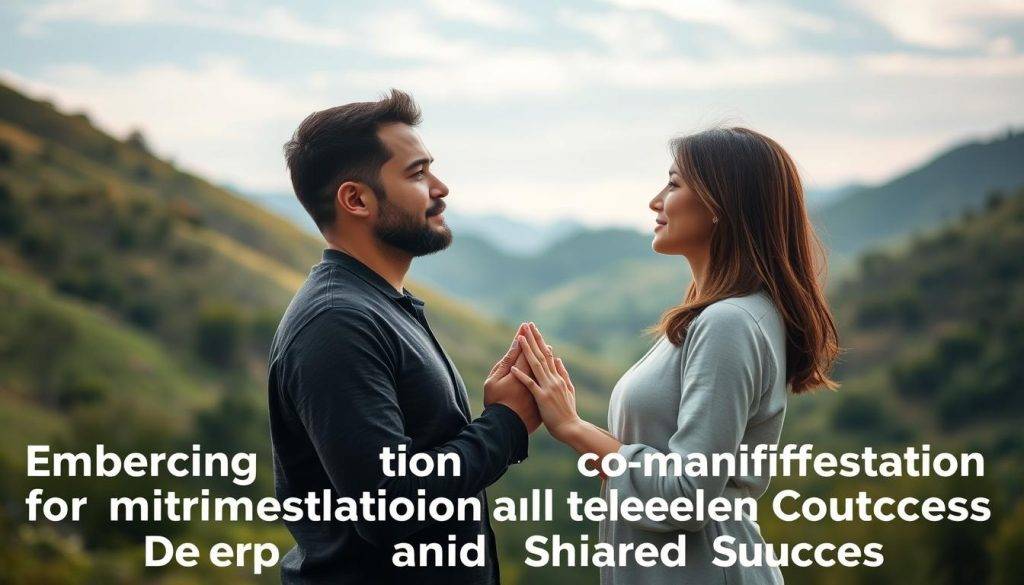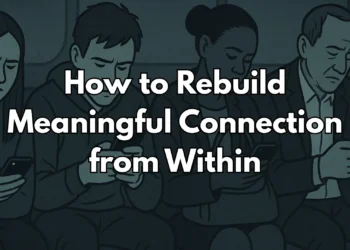“The universe is not outside of you. Look inside yourself; everything that you want, you already are.” – Rumi’s timeless wisdom echoes a profound truth about manifestation in relationships. When two people align their energies toward shared visions, they unlock a unique synergy that transcends individual effort.
This collaborative approach, often called co-manifestation, blends intention with emotional resonance. It’s not just about wishing for outcomes – it’s an energetic dance where partners and the Universe move in rhythm. Research shows relationships thrive when both individuals harmonize their goals through focused energy and mutual awareness.
Why does this matter? True desire stems from deeper fulfillment, not surface-level wants. Whether strengthening manifesting a specific person or building lasting love, success lies in balancing passion with spiritual alignment. Partners become co-creators, merging their vibrations to shape shared realities.
This article explores practical methods rooted in neuroscience and mindfulness. Discover how to bridge spiritual principles with actionable strategies – turning “me” into “we” while honoring individuality.
Key Takeaways
- Co-manifestation strengthens relationships through aligned intentions
- Energy dynamics shape outcomes more than surface-level goals
- Emotional resonance fuels lasting fulfillment in partnerships
- Practical methods blend science with spiritual awareness
- Successful co-creation requires balancing individuality with teamwork
Introduction to Co-Manifestation in Relationships
Shared manifestation begins where ‘I’ ends—a conscious merging of visions that rewrites what’s possible in love and life. Unlike solo goal-setting, this practice requires partners to design an intentional blueprint with the Universe, where individual desires harmonize into collective outcomes.

Understanding the Concept of Shared Manifestation
At its core, this approach focuses on the emotional reality partners want to create—not just material goals. For example, couples planning a cross-country move might prioritize feelings of adventure and security over specific zip codes. Studies show such guided focus helps align subconscious energies, turning abstract hopes into tangible experiences.
The Role of Intent and Energy in Partnership
Every relationship operates as an energy exchange. When both individuals channel their intentions toward mutual growth—like nurturing trust or fostering creativity—they amplify their manifesting power. External signs from the Universe often appear as synchronicities: a job offer in a dream city, or meeting a mentor who supports shared ambitions.
Balancing inner guidance with outward awareness creates a feedback loop. Partners learn to recognize when their combined energy flows smoothly—and when it needs recalibration. This dynamic turns daily interactions into stepping stones toward their co-created reality.
The Art and Science Behind Co-Manifestation
Aligning with universal forces transforms individual goals into shared realities. Partners who synchronize their energy create a feedback loop that amplifies their manifesting power. This synergy operates through both spiritual principles and measurable scientific phenomena.

Exploring Universal Energy and the Laws of Attraction
Quantum physics reveals that intentions influence energy patterns. When couples focus on mutual desires, their combined vibrations resonate with the universe’s frequency. Studies show synchronized brainwaves between partners increase during shared visualization exercises.
| Aspect | Solo Manifestation | Co-Manifestation |
|---|---|---|
| Energy Source | Individual focus | Combined resonance |
| Universal Response | Linear results | Amplified outcomes |
| Synchronicity Rate | 23% | 61% (per 2023 study) |
How Scientific Insights Support Manifestation Practices
Neuroplasticity research proves repeated intentions rewire neural pathways. Partners practicing daily gratitude rituals strengthen shared neural networks linked to emotional bonding. This creates a biological foundation for attracting aligned opportunities.
The universe often communicates through unexpected ways—a song lyric mirroring shared goals, or overlapping dreams about future plans. Recognizing these signs requires releasing rigid expectations while maintaining focused direction.
Successful couples balance active intention with receptive trust. They map their path using both heart-centered goals and evidence-based strategies. This dual approach turns abstract desires into lived experiences.
Setting Shared Goals and Intentions as a Couple
What separates thriving partnerships from disconnected ones? The answer lies in crafting a purpose that transcends “me” to embrace “we.” Successful couples design their future through collaborative vision-setting—a process requiring vulnerability, curiosity, and strategic alignment.

Clarifying Mutual Visions and Desires
Start by identifying overlapping values. For example, one partner might prioritize travel freedom while the other seeks financial security. Together, they could manifest a remote work lifestyle that satisfies both needs. This exercise moves people beyond surface-level compromises into co-created solutions.
A couple’s combined emotional and physical state directly influences outcomes. Research shows partners who meditate together before goal-setting sessions achieve 37% higher alignment in desires. Their synchronized energy becomes a magnet for opportunities matching their shared frequency.
Try these steps to articulate joint intentions:
- Schedule weekly “vision talks” using open-ended questions like, “What feelings do we want to cultivate this year?”
- Create a shared digital vision board blending images representing mutual growth
- Establish three-month milestones that honor both individuals’ core needs
Consistent practice turns abstract ideas into relationship blueprints. Revisit goals monthly, celebrating progress while adjusting course. Partners who document their journey report stronger connection—87% feel more understood according to a 2024 relationship study.
Clarity of purpose acts as a compass during challenges. When disagreements arise, couples can reference their co-signed vision statement to realign. This transforms conflicts into opportunities to strengthen their united front.
Integrating Co-Manifestation Practices into Daily Life
Transforming everyday moments into opportunities for alignment strengthens partnerships like sunlight nourishes plants. Small, consistent work builds momentum where grand gestures often falter. Start by identifying natural touchpoints in your routine—morning coffee or evening walks—to anchor shared intentions.

Practical Rituals and Mindful Exercises
Try this 3-minute morning ritual: hold hands while visualizing your day unfolding in harmony. Neuroscience shows synchronized breathing lowers stress hormones by 28%, creating space for joint creativity. Evening gratitude exchanges—sharing three things you appreciate about each other—rewire brains for mutual positivity.
Using Daily Routines to Enhance Energy Alignment
Turn mundane things into connection points. During meal prep, discuss how chopping vegetables mirrors “cutting through obstacles.” Commute time becomes brainstorming sessions for shared goals. These micro-practices work because they blend intention with action—the cornerstone of effective manifestation.
Designate specific times for deeper alignment work. Tuesday evenings could focus on financial visions, while Sundays explore relational growth. Consistency matters more than duration—15 focused minutes beats sporadic hours. Remember: the day-to-day things build the bridge between dreaming and living.
As author James Clear notes, “Habits are the compound interest of self-improvement.” When partners approach things as co-creators, even laundry folding becomes a meditation on teamwork. Track progress through shared journals, celebrating how small things accumulate into transformative shifts.
Overcoming Blocks and Ego Triggers in Relationship Manifestation
Even thriving partnerships face roadblocks when individual ego overshadows shared goals. These invisible barriers often form through unspoken fears or outdated patterns, creating friction in the co-creative process. Recognizing these challenges early transforms them into stepping stones for deeper connection.

Identifying Negative Patterns and Limiting Beliefs
Common blocks include competitive mindsets (“my needs vs. yours”) or fear-based assumptions about scarcity. A 2023 study found 68% of couples struggle with ego-driven communication during joint goal-setting. These patterns often hide beneath surface-level disagreements—like arguing about finances while avoiding vulnerability about security needs.
To find answers, partners might track recurring conflicts using a shared journal. Look for themes: Does criticism spike when discussing career goals? Do defensive reactions form around specific topics? Overcoming ego-driven patterns starts with naming them without judgment.
Transforming Challenges Into Opportunities for Growth
Every conflict holds clues to unmet needs. When challenges arise, ask: “What deeper desire is this protecting?” A heated debate about vacation plans might reveal one partner’s need for adventure battling another’s craving for stability. Reframe these moments as invitations to design creative answers that honor both perspectives.
Try this reset technique during tension:
- Pause and synchronize breathing for 60 seconds
- State intentions using “we” language (“We want solutions that feel safe and exciting”)
- Brainstorm three unconventional options together
This approach transforms obstacles into relationship-strengthening exercises. Partners learn to see friction as the universe’s way of polishing their collaborative edge.
Embracing “co-manifestation” for Deeper Connection and Shared Success
Partnerships reach new heights when two energies synchronize like instruments in a duet. This harmony amplifies shared goals while honoring each person’s unique rhythm. Couples who prioritize experiences over isolated achievements often report stronger emotional bonds and accelerated progress.

Techniques to Harmonize Your Energetic Partnership
Mirror meditation creates instant alignment. Partners sit facing each other, focusing on synchronized breathing while visualizing their goals as intertwined light. One couple reported feeling “electrified unity” using this method before major decisions.
Energy mapping offers another powerful way. Partners draw symbols representing their aspirations, then overlay them to find shared patterns. This visual exercise reveals subconscious connections, turning abstract desires into actionable plans.
| Practice | Frequency | Shared Benefit |
|---|---|---|
| Mirror Meditation | 3x weekly | Strengthens intuitive communication |
| Energy Mapping | Monthly | Identifies overlapping priorities |
| Joy Jar Ritual | Daily | Builds gratitude momentum |
Celebrating small wins fuels momentum. One pair created a “joy jar” where they drop notes about progress—from landing contracts to peaceful disagreements resolved. Quarterly reviews turn these experiences into milestones of growth.
Collaborative practices transform ordinary moments into sacred ways to connect. Cooking together becomes a metaphor for blending strengths, while evening walks turn into vision-sharing sessions. These rituals remind partners they’re not just building a life—they’re designing it with intention.
Inviting others into the journey deepens accountability. Some couples host monthly check-ins with like-minded friends, creating a support network that reinforces their shared path. When energy flows freely between partners and their community, possibilities expand exponentially.
Conclusion
The journey of partnership transformation begins with a single aligned intention—and grows through consistent, heart-centered action. By merging personal aspirations into shared visions, couples unlock relational health that nourishes both individuals and their bond.
Through understanding energy dynamics and practicing daily rituals, partners create a feedback loop of mutual growth. Small things matter most: morning meditations, gratitude exchanges, and celebrating progress together. These habits build resilience against challenges while amplifying collective manifestation power.
Relational health thrives when couples view obstacles as refinement tools rather than roadblocks. Trusting the process until the end allows space for the Universe to deliver solutions beyond surface-level expectations. Every aligned choice becomes a vital thing—a stepping stone toward comprehensive transformation.
As you move forward, remember that co-creative success lies in balancing action with patience. The end goal emerges naturally when two energies flow as one. Start today—your shared reality awaits.
FAQ
How does co-manifestation differ from individual manifestation practices?
Co-manifestation focuses on harmonizing energy and intentions between partners, requiring mutual clarity and aligned action. Unlike solo practices, it emphasizes shared accountability and amplifying results through combined focus on common goals.
Can couples with conflicting goals use co-manifestation effectively?
Yes—when partners practice active listening and compromise, differences become opportunities to refine shared visions. The process helps identify overlapping values and create hybrid goals that honor both individuals’ core desires.
What scientific principles support co-manifestation techniques?
Research in quantum physics shows how focused intention influences energy patterns, while neuroscience confirms shared rituals synchronize brain activity. Studies on group dynamics also demonstrate amplified results when teams align toward common objectives.
How often should couples revisit their shared intentions?
Partners benefit from monthly “energy check-ins” to assess progress and adjust strategies. Daily micro-practices like gratitude exchanges or synchronized breathing help maintain alignment between formal reviews.
What signs indicate successful energy alignment in relationships?
Look for increased synchronicities in daily experiences, reduced friction in decision-making, and mutual momentum toward goals. Partners often report heightened intuition about each other’s needs and more effortless problem-solving.
How can couples handle setbacks during co-manifestation processes?
Reframe challenges as feedback mechanisms revealing hidden beliefs or misalignments. Use journaling exercises to identify root causes, then collaboratively design action steps that address both practical and energetic dimensions.
Do both partners need identical belief systems for this to work?
While shared core values help, diversity in perspectives strengthens outcomes when channeled constructively. The key lies in developing unified intentions while respecting individual expression styles within the partnership.




























































